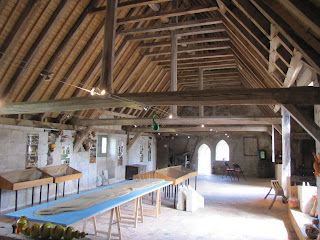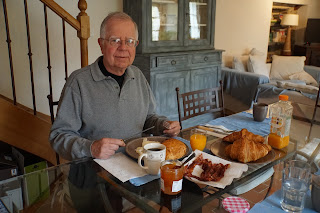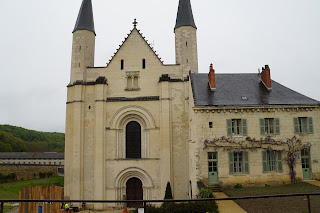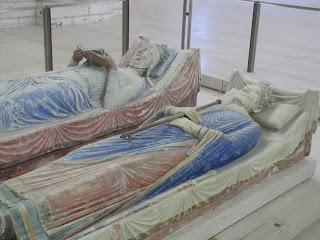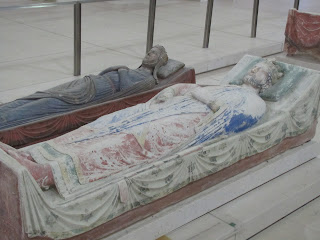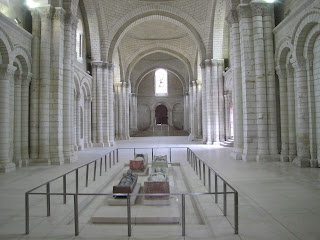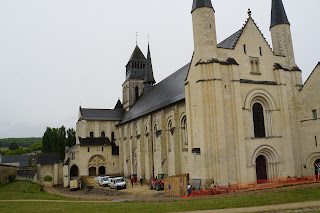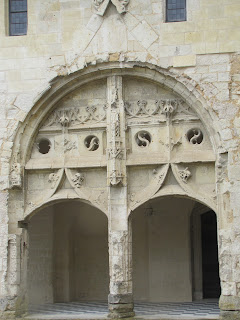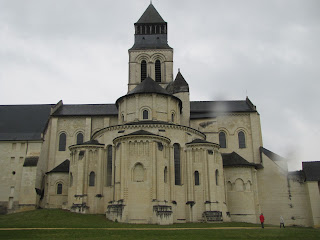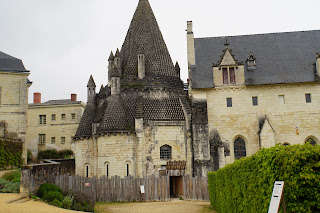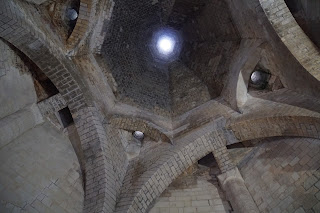 |
| Cointreau moved to the industrial park from central Angers in the 70s. |
In our travels yesterday, we made a reservation to tour of the Cointreau factory in St. Barthélemy, a suburb of Angers. Cointreau is also a Triple-Sec liqueur and they claim to have invented Triple Sec. Hmm.....That's not what we heard at Combier.
We arrived 15 minutes early (10:45) for our English speaking tour as instructed, but someone forgot to tell the tour guide to unlock the doors early.
 |
| A fine art photo by Clark Hunsinger entitled "Four tourists waiting for a tour at a liquor factory". |
So we entered at 11 and waited around another 15 minutes while our guide got things organized.
And at the last minute, two French couples entered, each pushing strollers with a 3 year-old in tow. They will join our tour, knowing it's in English. Right then and there, we know the tour will run long. In talking to one of the husbands, I learned that he works for Cointreau and his sister and brother-in-law are visiting. The 3-year-olds cousins, a boy and a girl, reminded me so much of Tristen and Evie. They were a joy to watch, even though they were driving their parents (and perhaps others on the tour) crazy.
We are taught about the making of Cointreau, an orange-flavored liqueur that we enjoy at home. In fact, the US is their biggest customer.
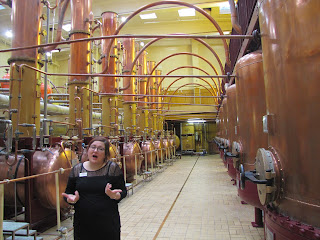 |
| The distillery and our tour guide Anne |
During the tour, we learn the history of Cointreau and are brought into a long hall of "communication", that is advertising. It seems that Cointreau spent half of its profits on advertising in the early days. And as far as their claim to have invented Triple Sec, they didn't. They began producing Cointreau in 1875 where Combier began producing Triple Sec in 1838. The difference might be that Combier did not patent their recipe, while Cointreau patented everything they could - the bottle shape, the logo, the ribbon on the bottle, the label. The recipe is a well-guarded secret known only to the woman who is the head distiller at Cointreau (and the guy at Combier, we think).
At the end of the hour and a half tour, we were brought to lovely tasting room to try a mixed drink with Cointreau, lime juice and carbonated water - a Cointreau Fizz. We preferred the Cointreau Noir and Blood Orange, both neat, to the Fizz.
 |
| Very modern tasting room at Cointreau. It was after noon when we started the cocktails |
We purchased a bottle of Noir and a bottle of the regular Cointreau. We'll report on our comparison taste-test with Combier in a later post.
We next set our GPS for St. Rémy la Varenne, the church and priory we visited on Monday.
 |
| Driving through St. Mathurin to cross to the south bank of the Loire at the next bridge |
There are picnic tables with a view of the church and the priory and church will both be open today. It's a lovely warm day for a picnic lunch with a view of the church.
The priory is much more interesting than we expected. Begun in the 10th century, it was attached to the Abbey St Aubin in Angers (of which nothing remains but a tower). A small group of Benedictine monks were dispatched to this priory to oversee its primarily agricultural mission.
Starting at the entry gate, we learned the meaning of the monkey carved into the arch. We had wondered about its significance on Monday. The chained monkey was a medieval symbol of slavery due to sin.
And of the lion, the symbol of St. Mark, symbolized justice and victory.
These sculptures flank the entrance gate to the priory, just on top of the side walls.
The priory chapel, also used as the chapter room, had remains of 12th century frescoes. It was quite small suggesting the priory had only a handful of monks.
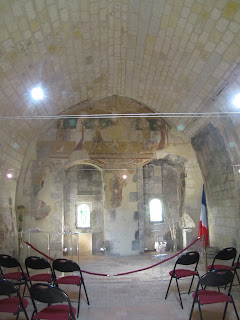 |
| chapter room with frescoed wall |
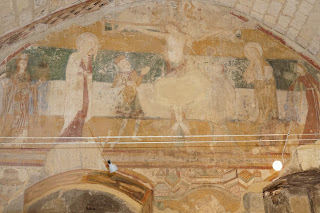 |
| Fresco of Christ on the cross with Mary in red on the left |
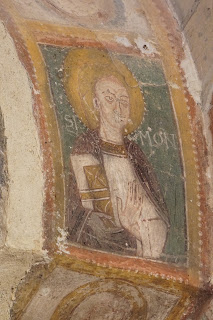 |
| fresco in archway below tympanum of Christ on the cross |
We next explored a large room that had been used for multiple purposes over the years. It has had some restoration which uncovered a painted mantel that was rather amazing and confusing and entertaining all at the same time.
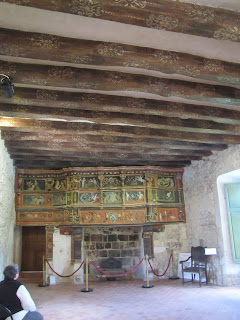 |
| The fireplace takes up the entire west wall of this room. We had entered the room via the door on the left. This room had been divided into 3 living spaces for poor families into the 20th century. Luckily the walls were whitewashed which protected the painting, but medallions embedded in the walls were hammered flat. |
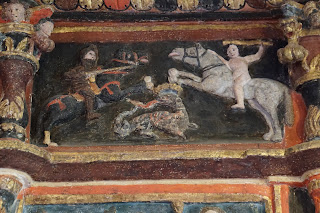 |
| A knight fighting a naked man with the salamander symbol of Francis I (Renaissance period) |
 |
| An inexplicable set of scenes included nymphs, jousting, a coat of arms surrounded by mermaids. Our information said no explanation has yet been uncovered |
 |
| This bas-relief of a woman arguing with her husband is one of my favorite panels. |
There is a local society for the preservation of this monument and it has done much restoration on the buildings. They have also provided (in English, no less) booklets in great detail about the rooms and history of the priory. The commentaries help us imagine how this priory was run. And we learned the difference between a priory and an abbey. Priories were satellites of an abbey, established as missionary "posts", or to manage agricultural properties of abbeys. An abbey could have many priories located near or far or even in foreign countries. This was especially true of Benedictine orders such as the Abbey St Aubin.
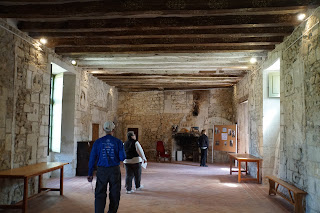 |
| Looking to other end of fireplace room. This room had been divided into 3 dwellings for the poor before becoming a property of the city, a national monument, and a UNESCO world heritage site. |
The fireplace room led to other rooms likely added in the 15th century. The priory was quite rich owing to its agricultural and pastoral success. The prior Mathurin Legay, who was of the nobility and not actually a monk, added these rooms to improve the comfort of the priory and make it more of a manor house than a monastery.
 |
| Modern stained glass with coat of arms for the Legay family. |
 |
| Coat of arms of another family influential in the priory's history |
As a result, these rooms are at different levels and open off a circular staircase at odd places. But they were definitely "more modern" than the original rooms.
The staircase ends at the level of a long attic space, recently renovated. This space was always used for storage it seems. The room seems to have become a museum for gourds of all sorts. Or a workshop for gourd decoration making. We never found out the significance of having an attic full of gourds.
Down a circular staircase at the other end of this room, we again encountered small square rooms that were obviously used for living spaces.
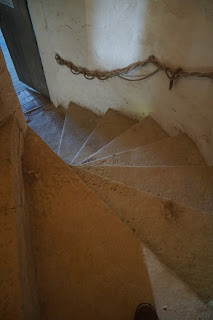 |
| 15th century circular staircase also provides access to the former first floor, now basement |
These rooms with fireplace and some furnishings are still whitewashed with multiple coats of paint but archaeologists have removed the whitewash in test areas which reveals that the walls were painted with many motifs. Restoration will be done in the future.
Once outside, we learned that the Loire River was once closer to the priory than it is now and that due to the building of a levee on the north side of the Loire across from St Rémy, the priory was frequently flooded.
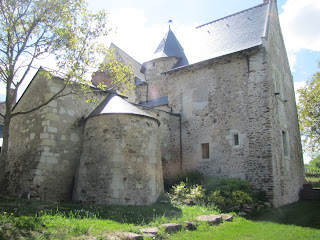 |
| From the north side of the building you can see that the priory has 3 floors. Only the top two floors were livable once the North side of the Loire built a levee causing frequent flooding on this, the south side of the Loire. |
So what was originally built as the ground floor, became unusable and the area around it filled in with soil on the south side so that now the original first floor is only a basement and not usable living space.
What we were seeing as a second floor was actually added in the 15th century and you can see the difference in the building materials between the original stone of the 12th century and the carved limestone of the 15th century. Also, the second story windows are typically Renaissance and more ornate than the 12th century priory would have had.
We next wandered over to the church which IS open today (in fact a woman is cleaning the pews while we are there). As the priory increased in riches and importance, the church was enlarged.
 |
| 1867 stained glass window in north end of church |
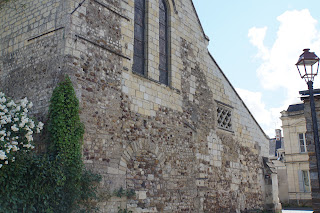 |
| This North side was probably the entrance to the original church. The long stained glass windows are a 19th century addition. (see above photo) |
The oldest part of the church probably is 10th century with the chancel built in 12th century Gothic style. Many modifications have been made, including 19th century renovations. The stained glass looks more modern than even that, but dates were not given.
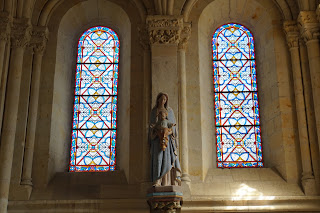 |
| The side chapel dedicated to Mary has modern windows |
 |
| Joan of Arc window, 1943 |
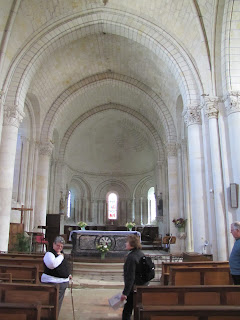 |
| "New" addition to church, 12th century |



















